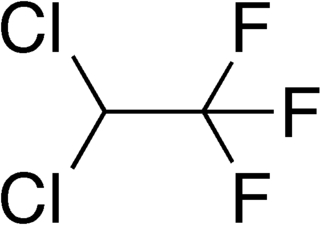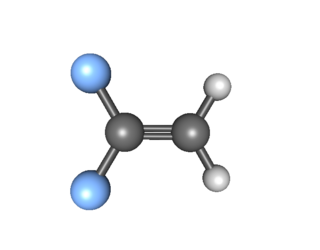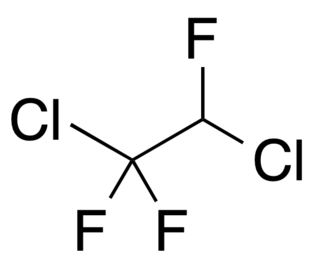
The organic compound 1,1,1-trichloroethane, also known as methyl chloroform and chlorothene, is a chloroalkane with the chemical formula CH3CCl3. It is an isomer of 1,1,2-trichloroethane. A colourless and sweet-smelling liquid, it was once produced industrially in large quantities for use as a solvent. It is regulated by the Montreal Protocol as an ozone-depleting substance and as such use has declined since 1996. Trichloroethane should not be confused with the similar-sounding trichloroethene which is also commonly used as a solvent.
Trifluoroethane may refer to either of two isomeric fluorocarbons which differ by the location of attachment of the fluorine atoms:
IARC group 3 substances, chemical mixtures and exposure circumstances are those that can not be classified in regard to their carcinogenicity to humans by the International Agency for Research on Cancer (IARC). This category is used most commonly for agents, mixtures and exposure circumstances for which the level of evidence of carcinogenicity is inadequate in humans and inadequate or limited in experimental animals. Exceptionally, agents (mixtures) for which the evidence of carcinogenicity is inadequate in humans, but sufficient in experimental animals may be placed in this category when there is strong evidence that the mechanism of carcinogenicity in experimental animals does not operate in humans. Agents, mixtures and exposure circumstances that do not fall into any other group are also placed in this category.
1,1-Dichloroethylene, commonly called vinylidene chloride or 1,1-DCE, is an organochloride with the molecular formula CHCl2CH3. It is a colorless liquid with a sharp odor. Like most chlorocarbons, it is poorly soluble in water but soluble in organic solvents. 1,1-DCE was the precursor to the original clingwrap, Saran, for food, but this application has been phased out.
Methylhydrazines are hydrazines that have additional methyl groups. Heavily methylated versions exist as hydrazinium salts.

2,2-Dichloro-1,1,1-trifluoroethane or HCFC-123 is considered as an alternative to CFC-11 in low pressure refrigeration and HVAC systems, and should not be used in foam blowing processes or solvent applications. It is also the primary component of the Halotron I fire-extinguishing mixture.

1,1,1-Trifluoroethane, or R-143a or simply trifluoroethane, is a hydrofluorocarbon (HFC) compound that is a colorless gas. It should not be confused with the much more commonly used HFC gas R-134a, nor confused with the isomeric compound 1,1,2-trifluoroethane. 1,1,1-Trifluoroethane has a critical temperature of 73 °C.
The molecular formula C6H12 may refer to following structural isomers:
1,1,2-Trichloro-1,2,2-trifluoroethane, also called trichlorotrifluoroethane or CFC-113, is a chlorofluorocarbon. It has the formula Cl2FC−CClF2. This colorless, volatile liquid is a versatile solvent.

Disiamylborane is an organoborane with the formula [( 2CHCH )2BH]2. It is a colorless waxy solid that is used in organic synthesis for hydroboration–oxidation reactions. Like most dialkyl boron hydrides, it has a dimeric structure with bridging hydrides.
The molecular formula C2HCl2F3 (molar mass: 152.93 g/mol, exact mass: 151.9407 u) may refer to:
Trichlorotrifluoroethane may refer to:

1,1-Difluoroethylene, also known as vinylidene fluoride, is a hydrofluoroolefin. This colorless, flammable gas is a difluorinated derivative of ethylene. Global production in 1999 was approximately 33,000 metric tons. It is primarily used in the production of fluoropolymers such as polyvinylidene fluoride and FKM.
Dehalogenimonas lykanthroporepellens is an anaerobic, Gram-negative bacteria in the phylum Chloroflexota isolated from a Superfund site in Baton Rouge, Louisiana. It is useful in bioremediation for its ability to reductively dehalogenate chlorinated alkanes.
1,1,1-Trichloro-2,2,2-trifluoroethane, also called Asymmetrical trichlorotrifluoroethane or CFC-113a, is a chlorofluorocarbon (CFC) with the formula CCl3CF3.
The molecular formula C2Cl3F3 (molar mass: 187.38 g/mol, exact mass: 185.9018 u) may refer to:

Triphenylethanol, or 1,1,2-triphenylethanol, is an organic compound with a condensed structural formula of (C
6H
5)
2C(OH)CH
2C
6H
5, and is related to triphenylethylene, from which it can be prepared by hydration. It is the structural analog of two drugs, the never-marketed antiestrogen ethamoxytriphetol (MER-25) and the withdrawn lipid-lowering agent triparanol, as both contain the 1,1,2-triphenylethanol moiety within their structure.

1,2-Dichloro-1,1,2-trifluoroethane is a volatile liquid chlorofluoroalkane composed of carbon, hydrogen, chlorine and fluorine, and with structural formula CClF2CHClF. It is also known as a refrigerant with the designation R-123a.

1,3-Dichloro-1,1,2,2,3-pentafluoropropane is a hydrochlorofluorocarbon. It is a volatile derivative of propane which has served as an HCFC replacement for the CFC, 1,1,2-trichloro-1,2,2-trifluoroethane which was used as a cleaning agent which has been used in the aerospace and electronics industries since the phase out of class 1 ozone depleting substances by the Montreal Protocol. As of 2015 with the phase out of hydrochlorofluorocarbons, HCFC-225 is included in this phase out, and applications where it was used must now be fulfilled by non-ozone depleting substances.

1,1-Dichlorotetrafluoroethane is a chlorofluorocarbon also known as CFC-114a or R114a by American Society of Heating, Refrigerating, and Air Conditioning Engineers. It has two chlorine atoms on one carbon atom and none on the other. It is one of two isomers of dichlorotetrafluoroethane, the other being 1,2-dichlorotetrafluoroethane, also known as CFC-114.









